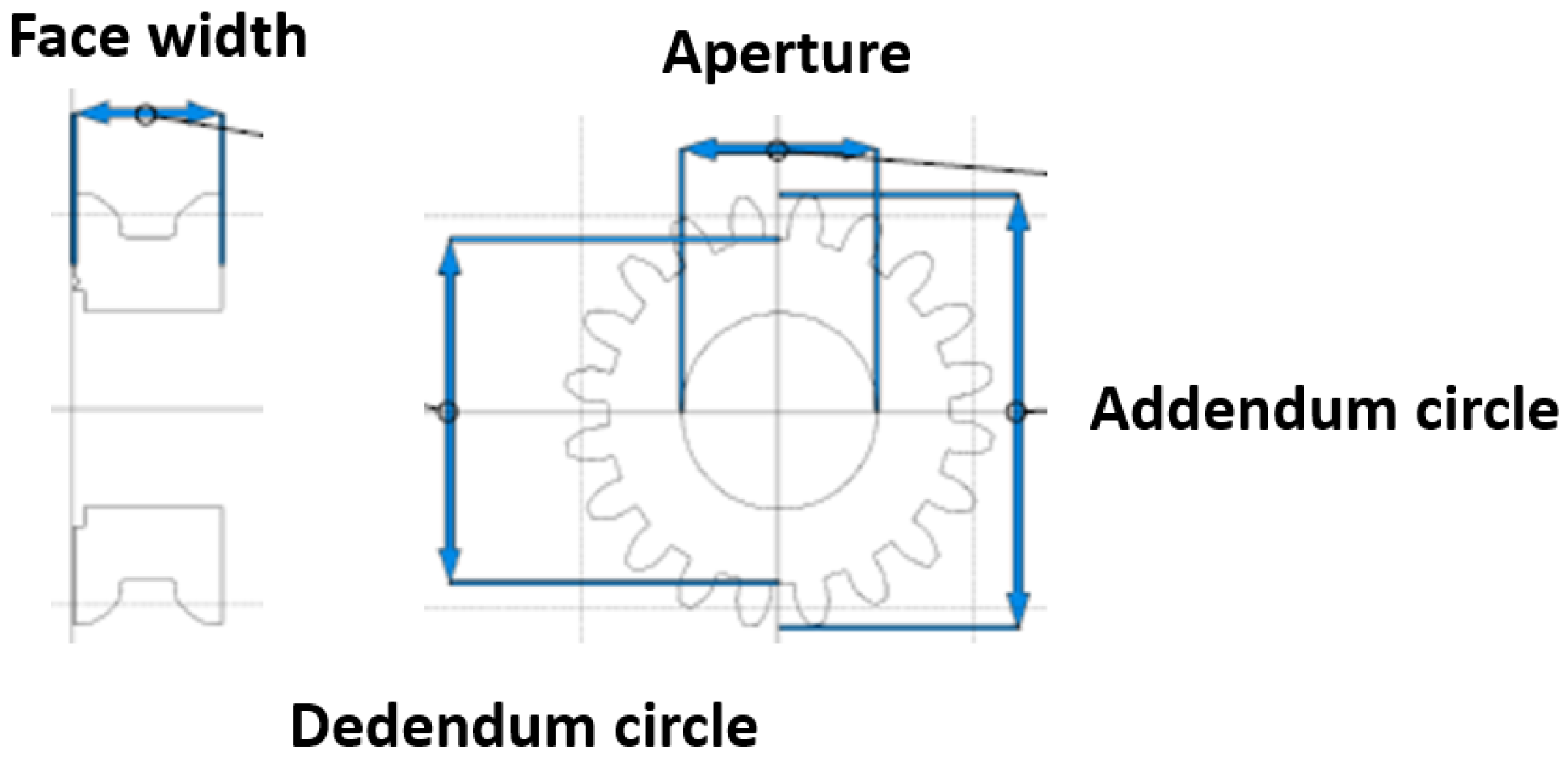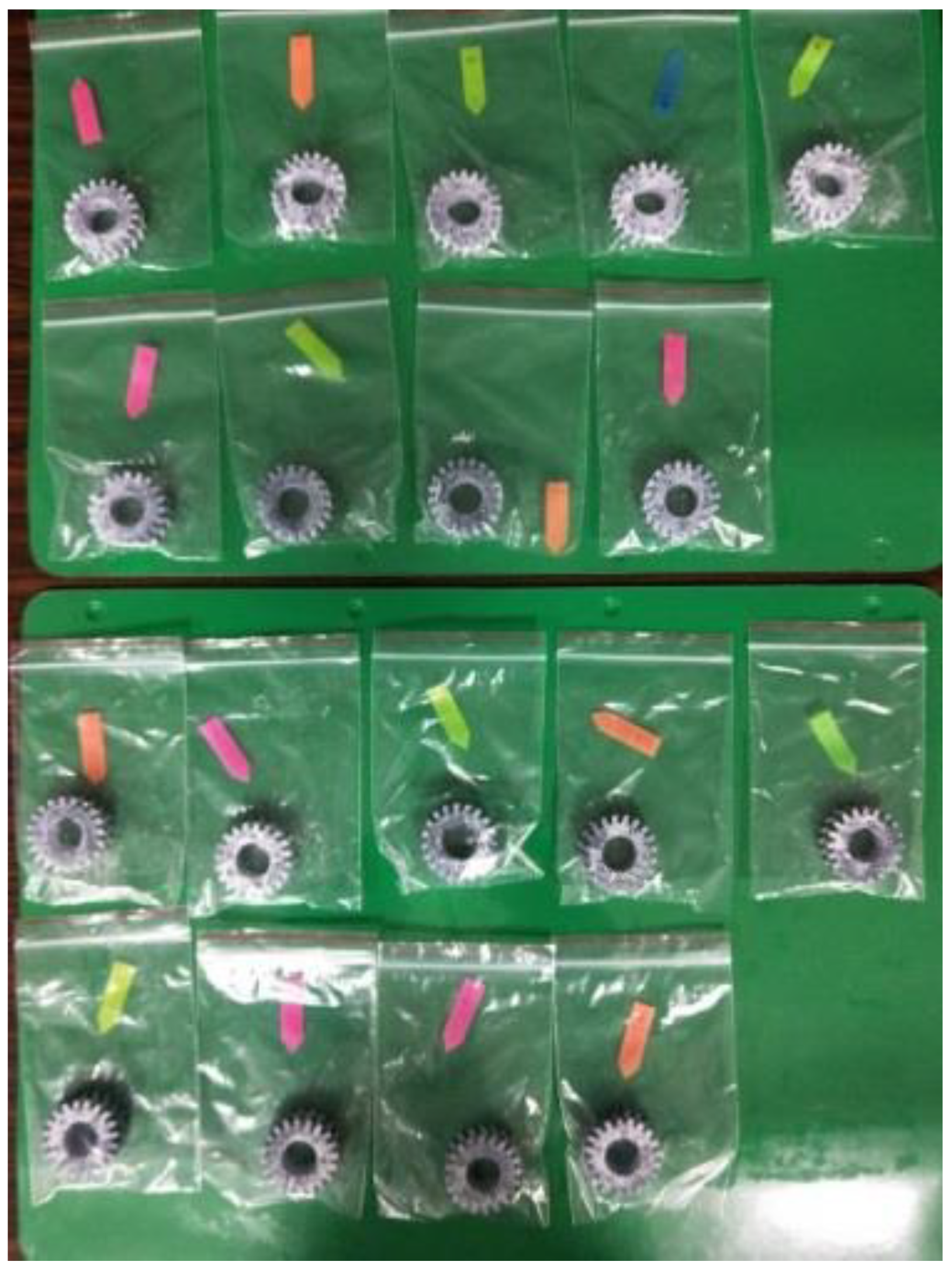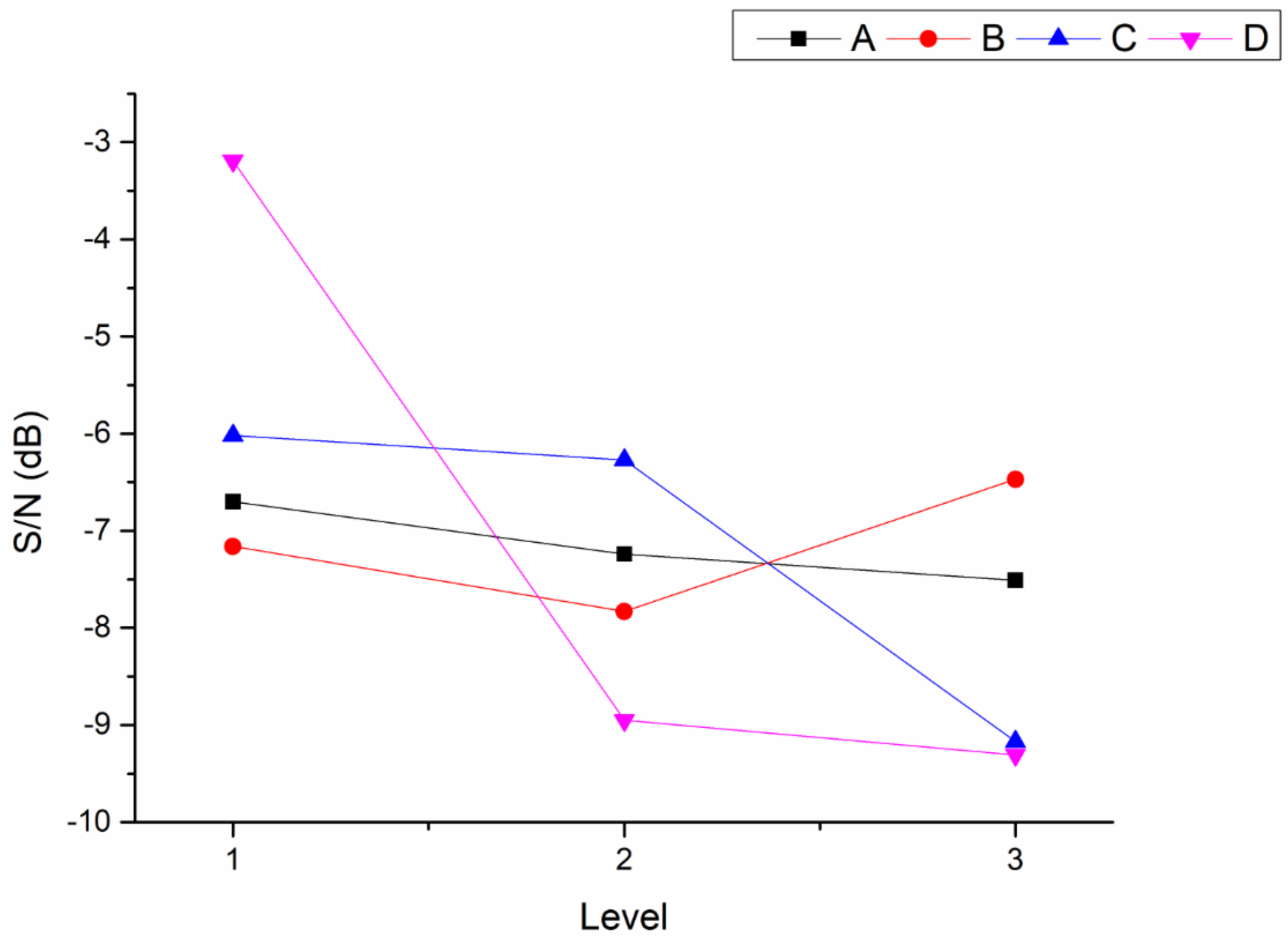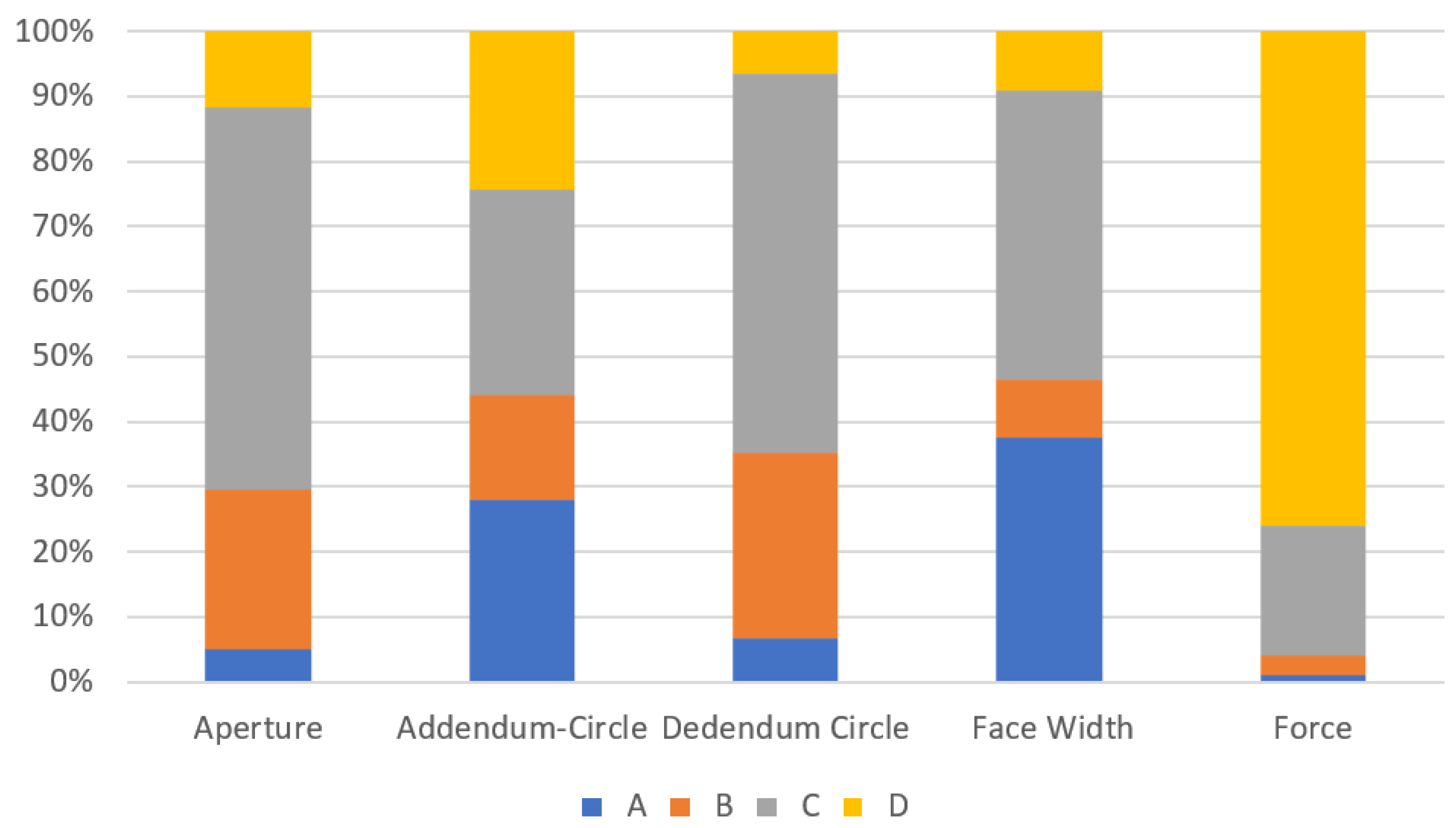Optimizing Manufacturing Parameters of DLP Machine by Taguchi Method and Desirability Approach
Abstract
1. Introduction
2. Materials and Methods
2.1. Printing Parameter of DLP Machine and Measuring System of Separation Force
- Slice thickness: Reference [22] points out that the separation force and dimensional tolerance will be changed with the change in slice thickness, so the slice thickness is selected as a control factor.
- Exposure duration: the curing degree of photosensitive resin will vary with different exposure durations, so the separation force and dimensional tolerance will be changed. In addition, considering that a stable bottom surface shall be provided in the initial printing stage, the exposure duration for layer 1 to layer 10 is set to 60 s in this experiment. The exposure duration for layer 11 to the end layer is a control factor.
- The rising speed of the forming platform: according to Newton’s second law of motion, the acceleration of an object is in direct proportion to the force applied to it. Any changes in the rising speed of the forming platform will generate different separation forces, which will affect the dimensional tolerance.
- The distance between the printed object and the fixed end of the resin tank: according to the moment theorem (moment = distance × applied force), it can be inferred that the length of the arm of force between the printed object and the fixed end of the resin tank will be changed with the change in the distance between the printed object and the fixed end of the resin tank, so that the separation force will be changed and the dimensional tolerance will be affected.
2.2. Geometric Characteristics and Quality Measurement of Printed Objects
2.3. Optimization of Single-Objective Printing Parameter—Taguchi Methods
2.4. Optimization of Multiobjective Printing Parameters—Desirability Approach
- I.
- Target the Response Desirability
- II.
- Minimize the Response Desirability
3. Results
3.1. Optimization of Single-Objective Printing Parameters—Minimum Separation Force
3.2. Optimization of Single-Objective Printing Parameters—Dimensional Tolerance
3.3. Multiobjective Printing Parameter Optimization—(1) Overall Dimensional Tolerance, (2) Separation Force, and Overall Dimensional Tolerance
4. Discussion
4.1. Optimization of Single-Objective Printing Parameters
4.2. Optimization of Multiobjective Printing Parameters
5. Conclusions
- The critical printing parameters affecting the magnitude of the separation force are the rising speed of the forming platform and the distance between the printed object and the fixed end of the solution tank. The separation force can be effectively reduced by slowing the rising speed of the platform and shortening the length of the force arm.
- The rising speed of the platform is the most critical parameter affecting the dimensional tolerance, but it reflects reverse characteristics in different geometric dimensions. The slower the platform rising speed, the better for the dimensional tolerance of the addendum circle; however, the faster the platform rising speed, the better the dimensional tolerance of the dedendum circle.
- The optimal dimensional tolerance of the aperture and the surface width shows a reverse characteristic in the layer thickness. The minimum aperture tolerance can be obtained by increasing the layer thickness to the maximum; otherwise, the minimum tolerance in the surface width can be obtained. The same characteristics are also reflected in the optimal tolerance of the separation force and addendum circle. The minimum separation force can be obtained by increasing the layer thickness to the maximum; otherwise, the minimum addendum circle tolerance can be obtained.
- In the case that the separation force and overall dimensional tolerance is minimized on the basis of the optimal printing parameters of the aperture tolerance, the objective can be achieved by increasing the distance between the printed object and the fixed end of the solution tank will enlarge the aperture tolerance. It is helpful to reduce the other three-dimensional tolerances and the separation force, so as to optimize all objects.
- It will not change the optimal printing parameters considering the minimum separation force and the overall dimensional tolerance, regardless of the weight of the separation force. This means that the only way is to select the optimal solution considering the separation force and the tolerance in the overall dimensions.
- The change in the resin tank structure can be incorporated into the follow-up study on printing quality optimization without changing the separation way of the cured layers. In addition, the changes in post-exposure time can also be involved into an optimization goal. Some studies have pointed out that this is also a factor that affects the dimensional accuracy and mechanical strength. Therefore, the tests after printing related to the mechanical properties can also be incorporated into the optimization objectives, such as meshing, tooth contact force, and noise. Finally, green manufacturing has become an important issue on sustainability, so it is also worth attempting to incorporate the carbon emissions from the energy consumption and the volatile organic compounds generated in the manufacturing process in the study.
Supplementary Materials
Funding
Institutional Review Board Statement
Informed Consent Statement
Data Availability Statement
Conflicts of Interest
References
- Yanar, N.; Kallem, P.; Son, M.; Park, H.; Kang, S.; Choi, H. A New era of water treatment technologies: 3D printing for membranes. J. Ind. Eng. Chem. 2020, 91, 1–14. [Google Scholar] [CrossRef]
- Mostafa, K.G.; Arshad, M.; Ullah, A.; Nobes, D.S.; Qureshi, A.J. Concurrent Modelling and Experimental Investigation of Material Properties and Geometries Produced by Projection Microstereolithography. Polymers 2020, 12, 506. [Google Scholar] [CrossRef] [PubMed]
- Li, Y.; Mao, Q.; Li, X.; Yin, J.; Wang, Y.; Fu, J.; Huang, Y. High-fidelity and high-efficiency additive manufacturing using tunable pre-curing digital light processing. Addit. Manuf. 2019, 30, 100889. [Google Scholar] [CrossRef]
- Pagac, M.; Hajnys, J.; Ma, Q.-P.; Jancar, L.; Jansa, J.; Stefek, P.; Mesicek, J. A Review of Vat Photopolymerization Technology: Materials, Applications, Challenges, and Future Trends of 3D Printing. Polymers 2021, 13, 598. [Google Scholar] [CrossRef] [PubMed]
- Wang, J.; Das, S.; Rai, R.; Zhou, C. Data-driven simulation for fast prediction of pull-up process in bottom-up ste-reo-lithography. Comput.-Aided Des. 2018, 99, 29–42. [Google Scholar] [CrossRef]
- Ding, H.; Dong, M.; Zheng, Q.; Wu, Z.L. Digital light processing 3D printing of hydrogels: A minireview. Mol. Syst. Des. Eng. 2022, 7, 1017–1029. [Google Scholar] [CrossRef]
- Santoliquido, O.; Colombo, P.; Ortona, A. Additive Manufacturing of ceramic components by Digital Light Pro-cessing: A comparison between the “bottom-up” and the “top-down” approaches. J. Eur. Ceram. Soc. 2019, 39, 2140–2148. [Google Scholar] [CrossRef]
- Pan, Y.; He, H.; Xu, J.; Feinerman, A. Study of separation force in constrained surface projection stereolithography. Rapid Prototyp. J. 2017, 23, 353–361. [Google Scholar] [CrossRef]
- Wang, J.C.; Ruilova, M.; Lin, Y.H. The development of an active separation method for bottom-up ste-reolithography system. In Proceedings of the 2017 IEEE/SICE International Symposium on System Integration (SII), Taipei, Taiwan, 11–14 December 2017; IEEE: New York, NY, USA, 2017; pp. 108–114. [Google Scholar]
- Kazemi, M.; Rahimi, A. Improving the efficiency of fabrication of AM parts by segmentation design in DLP process. Rapid Prototyp. J. 2019, 25, 1155–1168. [Google Scholar] [CrossRef]
- Jin, J.; Yang, J.; Mao, H.; Chen, Y. A vibration-assisted method to reduce separation force for stereolithography. J. Manuf. Process. 2018, 34, 793–801. [Google Scholar] [CrossRef]
- Xu, Y.; Zhu, Y.; Sun, Y.; Jin, J.; Chen, Y. A vibration-assisted separation method for constrained-surface-based ste-reolithography. J. Manuf. Sci. Eng. 2021, 143, 051008. [Google Scholar] [CrossRef]
- Lin, Y.-S.; Yang, C.-J. Spring Assisting Mechanism for Enhancing the Separation Performance of Digital Light Process 3D Printers. IEEE Access 2019, 7, 71718–71729. [Google Scholar] [CrossRef]
- Wu, X.; Xu, C.; Zhang, Z.; Jin, Z. Tilting separation simulation and theory verification of mask projection stereo-lithography process. Rapid Prototyp. J. 2021, 21, 851–860. [Google Scholar] [CrossRef]
- He, H.; Xu, J.; Yu, X.; Pan, Y. Effect of constrained surface texturing on separation force in projection stereolithog-raphy. J. Manuf. Sci. Eng. 2018, 140, 091007. [Google Scholar] [CrossRef]
- Gritsenko, D.; Ahmadian Yazdi, A.; Lin, Y.; Hovorka, V.; Pan, Y.; Xu, J. On characterization of separation force for resin replenishment enhancement in 3D printing. Addit. Manuf. 2017, 17, 151–156. [Google Scholar] [CrossRef]
- Jiang, Y.; Wang, Y.; He, H.; Feinerman, A.; Pan, Y. Constrained Window Design in Projection Stereolithography for Continuous Three-Dimensional Printing. 3D Print. Addit. Manuf. 2020, 7, 163–169. [Google Scholar] [CrossRef]
- Wu, X.; Xu, C.; Zhang, Z. Flexible film separation analysis of LCD based mask stereolithography. J. Mater. Process. Technol. 2020, 288, 116916. [Google Scholar] [CrossRef]
- Yang, F.; Kazi, A.; Marmo, A.; Grunlan, M.A.; Tai, B.L. Characterizing the separation behavior of photocurable PDMS on a hydrogel film during vat photopolymerization: A benchmark study. Addit. Manuf. 2022, 58, 103070. [Google Scholar] [CrossRef]
- Ye, H.; Venketeswaran, A.; Das, S.; Zhou, C. Investigation of separation force for constrained-surface stereolithog-raphy process from mechanics perspective. Rapid Prototyp. J. 2017, 23, 696–710. [Google Scholar] [CrossRef]
- Jumbo-Jaramillo, I.; Lara-Padilla, H. Digital Model to Predict Failures of Porous Structures in DLP-Based Ad-ditive Manufacturing. In Proceedings of the XV Multidisciplinary International Congress on Science and Technology, Quito, Ecuador, 14–18 June 2021; Springer: New York, NY, USA, 2021; pp. 219–228. [Google Scholar]
- Kovalenko, I.; Garan, M.; Shynkarenko, A.; Zelený, P.; Šafka, J. Examining the Relationship between Forces During Stereolithography 3D Printing and Geometric Parameters of the Model. MATEC Web Conf. 2016, 40, 2005. [Google Scholar] [CrossRef]
- Gritsenko, D.; Paoli, R.; Xu, J. The Effect of Acceleration on the Separation Force in Constrained-Surface Stereo-lithography. Appl. Sci. 2022, 12, 442. [Google Scholar] [CrossRef]
- Yadegari, F.; Fesharakifard, R.; Barazandeh, F. Numerical and experimental investigation of effective parameters on separation force in bottom-up stereolithography process. AUT J. Mech. Eng. 2021, 5, 4. [Google Scholar]
- Wu, X.; Lian, Q.; Li, D.; Jin, Z. Tilting separation analysis of bottom-up mask projection stereolithography based on cohesive zone model. J. Mater. Process. Technol. 2017, 243, 184–196. [Google Scholar] [CrossRef]
- Zamheri, A.; Seprianto, D.; Carlos, R.; Indri, A.; Persada, T. The Effect of Parameter Process 3D Printer Technology Digital Light Processing to Geometric of Shaft. In Proceedings of the 4th Forun in Research, Science, and Technology, Palembang, Indonesia, 10–11 November 2021; pp. 238–243. [Google Scholar] [CrossRef]
- Putra, D.P.; Romli; Yanis, M.; Seprianto, D.; Amrillah, N.; Basri, H. Optimization of Production Process Parameters of DLP Type 3D Printer Design for Product Roughness Value. In Proceedings of the 4th Forun in Research, Science, and Technology, Palembang, Indonesia, 10–11 November 2021; pp. 179–183. [Google Scholar] [CrossRef]
- Kudo 3D. Available online: https://www.kudo3d.com/ (accessed on 10 August 2022).
- 3DM Advanced Materials. Available online: https://www.3dm-shop.com/ (accessed on 10 August 2022).
- OMEGA Engineering. Available online: https://www.omega.com/pptst/LC201.html (accessed on 10 August 2022).
- National Instruments. Available online: http://www.ni.com/en-gb/support/model.usb-6002.html (accessed on 10 August 2022).
- Piedra-Cascón, W.; Krishnamurthy, V.R.; Att, W.; Revilla-León, M. 3D printing parameters, supporting structures, slicing, and post-processing procedures of vat-polymerization additive manufacturing technologies: A narrative review. J. Dent. 2021, 109, 103630. [Google Scholar] [CrossRef]





| Tems | Value/Unit |
|---|---|
| Number of gear teeth | 20 teeth |
| Face width | 15.00 mm |
| Modulus | 2 |
| Pitch diameter | 40 mm |
| Addendum circle | 43.98 mm |
| Dedendum circle | 35.00 mm |
| Aperture | 20.00 mm |
| Control Factors | Description | Level | Experimental Parameters |
|---|---|---|---|
| A | Slice thickness | 1 | 0.20 mm |
| 2 | 0.15 mm | ||
| 3 | 0.10 mm | ||
| B | Exposure duration | 1 | 30 s |
| 2 | 35 s | ||
| 3 | 40 s | ||
| C | Rising speed of forming platform | 1 | 10 mm/min |
| 2 | 15 mm/min | ||
| 3 | 20 mm/min | ||
| D | Distance between the printed object and fixed end of solution tank | 1 | 97.87 mm |
| 2 | 99.87 mm | ||
| 3 | 101.87 mm |
| Experimental No. | Factors | |||
|---|---|---|---|---|
| A | B | C | D | |
| 1 | 1 | 1 | 1 | 1 |
| 2 | 1 | 2 | 2 | 2 |
| 3 | 1 | 3 | 3 | 3 |
| 4 | 2 | 1 | 2 | 3 |
| 5 | 2 | 2 | 3 | 1 |
| 6 | 2 | 3 | 1 | 2 |
| 7 | 3 | 1 | 3 | 2 |
| 8 | 3 | 2 | 1 | 3 |
| 9 | 3 | 3 | 2 | 1 |
| Group | Separation Force (in: Newton) | - | |||
|---|---|---|---|---|---|
| Experiment 1 | Experiment 2 | Mean Value | Standard Deviation | S/N | |
| 1 | 1.04 | 1.35 | 1.20 | 0.22 | −1.62 |
| 2 | 2.22 | 2.93 | 2.58 | 0.50 | −8.30 |
| 3 | 3.21 | 3.26 | 3.24 | 0.04 | −10.20 |
| 4 | 2.13 | 3.11 | 2.62 | 0.69 | −8.52 |
| 5 | 2.00 | 1.98 | 1.99 | 0.01 | −5.98 |
| 6 | 1.19 | 3.02 | 2.11 | 1.29 | −7.22 |
| 7 | 2.97 | 4.29 | 3.63 | 0.93 | −11.34 |
| 8 | 3.24 | 2.49 | 2.87 | 0.53 | −9.22 |
| 9 | 1.19 | 1.32 | 1.26 | 0.10 | −1.98 |
| Control Factors | ||||
|---|---|---|---|---|
| - | A | B | C | D |
| Level 1 | −6.70 | −7.16 | −6.02 | −3.19 |
| Level 2 | −7.24 | −7.83 | −6.27 | −8.95 |
| Level 3 | −7.51 | −6.47 | −9.17 | −9.31 |
| Maximum difference | 0.81 | 1.36 | 3.15 | 6.12 |
| Factors | Dof | Adj SS | Adj MS | V | SS’ | Contribution |
|---|---|---|---|---|---|---|
| A | 2 | 1.01 | 0.51 | 0.51 | 1.01 | 1.09% |
| B | 2 | 2.79 | 1.40 | 1.40 | 2.79 | 3.00% |
| C | 2 | 18.45 | 9.23 | 9.23 | 18.45 | 19.85% |
| D | 2 | 70.68 | 35.34 | 35.34 | 70.68 | 76.06% |
| Total | 8 | 92.93 | 92.93 | 100% |
| Group | Aperture | Addendum Circle | Dedendum Circle | Face Width | ||||||||
|---|---|---|---|---|---|---|---|---|---|---|---|---|
| Mean Value | Standard Deviation | S/N | Mean Value | Standard Deviation | S/N | Mean Value | Standard Deviation | S/N | Mean Value | Standard Deviation | S/N | |
| 1 | 19.98 | 0.06 | 49.94 | 44.39 | 0.03 | 63.91 | 35.14 | 0.05 | 57.02 | 15.11 | 0.37 | 32.11 |
| 2 | 19.99 | 0.01 | 69.02 | 44.20 | 0.18 | 47.62 | 35.11 | 0.06 | 54.83 | 14.81 | 0.13 | 41.32 |
| 3 | 20.08 | 0.07 | 49.07 | 44.38 | 0.08 | 55.13 | 35.36 | 0.03 | 61.94 | 14.99 | 0.51 | 29.38 |
| 4 | 20.06 | 0.03 | 57.02 | 44.30 | 0.08 | 54.35 | 35.30 | 0.07 | 53.97 | 15.19 | 0.13 | 41.54 |
| 5 | 19.96 | 0.06 | 50.95 | 44.14 | 0.26 | 44.54 | 35.14 | 0.01 | 67.91 | 14.92 | 0.15 | 40.04 |
| 6 | 19.91 | 0.04 | 53.43 | 44.24 | 0.08 | 55.10 | 35.13 | 0.04 | 58.36 | 14.73 | 0.22 | 36.54 |
| 7 | 19.95 | 0.08 | 48.18 | 44.26 | 0.17 | 48.33 | 35.20 | 0.05 | 57.04 | 14.91 | 0.15 | 40.03 |
| 8 | 20.02 | 0.04 | 55.06 | 44.50 | 0.02 | 66.43 | 35.67 | 0.02 | 64.51 | 15.21 | 0.20 | 37.71 |
| 9 | 19.94 | 0.04 | 55.02 | 44.34 | 0.01 | 75.95 | 35.42 | 0.14 | 47.97 | 14.85 | 0.10 | 43.52 |
| Items | Importance of Factors | Optimal Parameters |
|---|---|---|
| Separation force | D > C > B > A | A1, B3, C1, D1 |
| Aperture | C > B > D > A | A1, B2, C2, D2 |
| Addendum circle | C > A > D > B | A3, B3, C1, D1 |
| Dedendum circle | C > B > A > D | A2, B2, C3, D3 |
| Face width | C > A > B > D | A3, B2, C2, D2 |
| Multiobjective | Description | Optimal Printing Parameters |
|---|---|---|
| 1 | All dimensional tolerance | A3, B1, C2, D1 |
| 2 | Force (90%) & all dimensional tolerance (10%) | A1, B2, C2, D1 |
| Force (80%) & all dimensional tolerance (20%) | ||
| Force (70%) & all dimensional tolerance (30%) | ||
| Force (60%) & all dimensional tolerance (40%) | ||
| Force (50%) & all dimensional tolerance (50%) | ||
| Force (40%) & all dimensional tolerance (60%) | ||
| Force (30%) & all dimensional tolerance (70%) | ||
| Force (20%) & all dimensional tolerance (80%) | ||
| Force (10%) & all dimensional tolerance (90%) |
Publisher’s Note: MDPI stays neutral with regard to jurisdictional claims in published maps and institutional affiliations. |
© 2022 by the author. Licensee MDPI, Basel, Switzerland. This article is an open access article distributed under the terms and conditions of the Creative Commons Attribution (CC BY) license (https://creativecommons.org/licenses/by/4.0/).
Share and Cite
Yang, C.-J. Optimizing Manufacturing Parameters of DLP Machine by Taguchi Method and Desirability Approach. Machines 2022, 10, 901. https://doi.org/10.3390/machines10100901
Yang C-J. Optimizing Manufacturing Parameters of DLP Machine by Taguchi Method and Desirability Approach. Machines. 2022; 10(10):901. https://doi.org/10.3390/machines10100901
Chicago/Turabian StyleYang, Cheng-Jung. 2022. "Optimizing Manufacturing Parameters of DLP Machine by Taguchi Method and Desirability Approach" Machines 10, no. 10: 901. https://doi.org/10.3390/machines10100901
APA StyleYang, C.-J. (2022). Optimizing Manufacturing Parameters of DLP Machine by Taguchi Method and Desirability Approach. Machines, 10(10), 901. https://doi.org/10.3390/machines10100901






